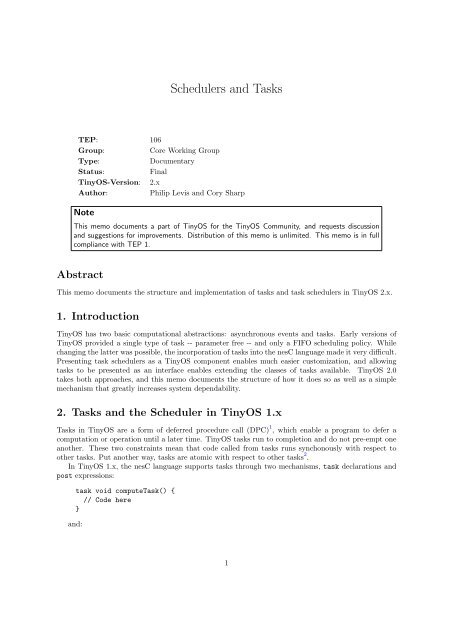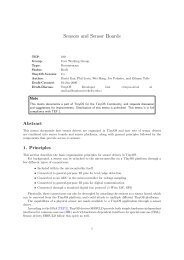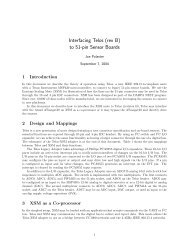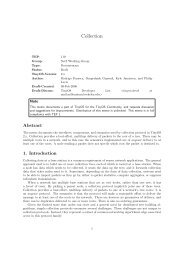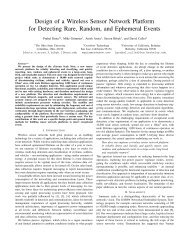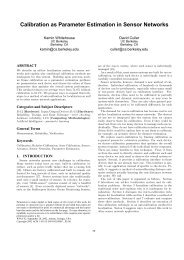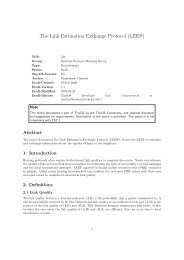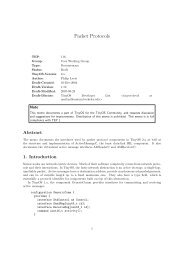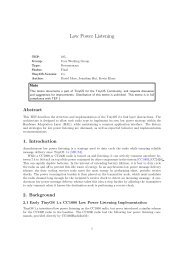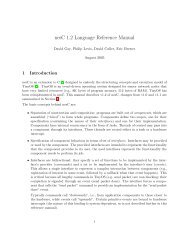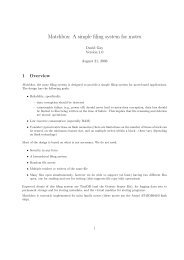Schedulers and Tasks - TinyOS
Schedulers and Tasks - TinyOS
Schedulers and Tasks - TinyOS
You also want an ePaper? Increase the reach of your titles
YUMPU automatically turns print PDFs into web optimized ePapers that Google loves.
<strong>Schedulers</strong> <strong>and</strong> <strong>Tasks</strong><br />
TEP: 106<br />
Group: Core Working Group<br />
Type: Documentary<br />
Status: Final<br />
<strong>TinyOS</strong>-Version: 2.x<br />
Author: Philip Levis <strong>and</strong> Cory Sharp<br />
Note<br />
This memo documents a part of <strong>TinyOS</strong> for the <strong>TinyOS</strong> Community, <strong>and</strong> requests discussion<br />
<strong>and</strong> suggestions for improvements. Distribution of this memo is unlimited. This memo is in full<br />
compliance with TEP 1.<br />
Abstract<br />
This memo documents the structure <strong>and</strong> implementation of tasks <strong>and</strong> task schedulers in <strong>TinyOS</strong> 2.x.<br />
1. Introduction<br />
<strong>TinyOS</strong> has two basic computational abstractions: asynchronous events <strong>and</strong> tasks. Early versions of<br />
<strong>TinyOS</strong> provided a single type of task -- parameter free -- <strong>and</strong> only a FIFO scheduling policy. While<br />
changing the latter was possible, the incorporation of tasks into the nesC language made it very difficult.<br />
Presenting task schedulers as a <strong>TinyOS</strong> component enables much easier customization, <strong>and</strong> allowing<br />
tasks to be presented as an interface enables extending the classes of tasks available. <strong>TinyOS</strong> 2.0<br />
takes both approaches, <strong>and</strong> this memo documents the structure of how it does so as well as a simple<br />
mechanism that greatly increases system dependability.<br />
2. <strong>Tasks</strong> <strong>and</strong> the Scheduler in <strong>TinyOS</strong> 1.x<br />
<strong>Tasks</strong> in <strong>TinyOS</strong> are a form of deferred procedure call (DPC) 1 , which enable a program to defer a<br />
computation or operation until a later time. <strong>TinyOS</strong> tasks run to completion <strong>and</strong> do not pre-empt one<br />
another. These two constraints mean that code called from tasks runs synchonously with respect to<br />
other tasks. Put another way, tasks are atomic with respect to other tasks 2 .<br />
In <strong>TinyOS</strong> 1.x, the nesC language supports tasks through two mechanisms, task declarations <strong>and</strong><br />
post expressions:<br />
task void computeTask() {<br />
// Code here<br />
}<br />
<strong>and</strong>:<br />
1
esult_t rval = post computeTask();<br />
<strong>TinyOS</strong> 1.x provides a single kind of task, a parameter-free function, <strong>and</strong> a single scheduling policy,<br />
FIFO. post expressions can return FAIL, to denote that <strong>TinyOS</strong> was unable to post the task. <strong>Tasks</strong><br />
can be posted multiple times. For example, if a task is posted twice in quick succession <strong>and</strong> the first<br />
succeeds while the second fails, then the task will be run once in the future; for this reason, even if a<br />
post fails, the task may run.<br />
The <strong>TinyOS</strong> 1.x scheduler is implemented as a set of C functions in the file sched.c. Modifying the<br />
scheduler requires replacing or changing this file. Additionally, as tasks are supported solely through<br />
nesC task declarations <strong>and</strong> post expressions, which assume a parameter-free function, modifying the<br />
syntax or capabilities of tasks is not possible.<br />
The task queue in <strong>TinyOS</strong> 1.x is implemented as a fixed size circular buffer of function pointers.<br />
Posting a task puts the task’s function pointer in the next free element of the buffer; if there are no free<br />
elements, the post returns fail. This model has several issues:<br />
1) Some components do not have a reasonable response to a failed post<br />
2) As a given task can be posted multiple times, it can consume more than one<br />
element in the buffer<br />
3) All tasks from all components share a single resource: one misbehaving component<br />
can cause other’s posts to fail<br />
Fundamentally, in order for a component A to repost a task after post failure, another component<br />
B must call a function on it (either a comm<strong>and</strong> or event). E.g., component A must schedule a timer, or<br />
expect a retry from its client. However, as many of these systems might depend on tasks as well (e.g.,<br />
timers), it is possible that an overflowing task queue can cause the entire system to fail.<br />
The combination of the above three issues mean that one misbehaving component can cause <strong>TinyOS</strong><br />
to hang. Consider, for example, this scenario (a real <strong>and</strong> encountered problem on the Telos platform):<br />
• A packet-based hardware radio, which issues an interrupt only when it finishes sending<br />
a packet<br />
• A networking component that h<strong>and</strong>les the interrupt to post a task to signal SendMsg.sendDone.<br />
• A sensing component that posts a task when it h<strong>and</strong>les an ADC.dataReady event<br />
• An application component that sends a packet <strong>and</strong> then sets its ADC sampling rate<br />
too high<br />
In this scenario, the sensing component will start h<strong>and</strong>ling events at a faster rate than it can process<br />
them. It will start posting tasks to h<strong>and</strong>le the data it receives, until it fills the task queue. At some<br />
point later, the radio finishes sending a packet <strong>and</strong> signals its interrupt. The networking component,<br />
however, is unable to post its task that signals SendMsg.sendDone(), losing the event. The application<br />
component does not try to send another packet until it knows the one it is sending completes (so it can<br />
re-use the buffer). As the sendDone() event was lost, this does not occur, <strong>and</strong> the application stops<br />
sending network traffic.<br />
The solution to this particular problem in <strong>TinyOS</strong> 1.x is to signal sendDone() in the radio send<br />
complete interrupt if the post fails: this violates the sync/async boundary, but the justification is that a<br />
possible rare race condition is better than certain failure. Another solution would be to use an interrupt<br />
source to periodically retry posting the task; while this does not break the sync/async boundary, until<br />
the post succeeds the system cannot send packets. The <strong>TinyOS</strong> 1.x model prevents it from doing any<br />
better.<br />
3. <strong>Tasks</strong> in <strong>TinyOS</strong> 2.x<br />
The semantics of tasks in <strong>TinyOS</strong> 2.x are different than those in 1.x. This change is based on experiences<br />
with the limitations <strong>and</strong> run time errors that the 1.x model introduces. In <strong>TinyOS</strong> 2.x, a basic post<br />
2
will only fail if <strong>and</strong> only if the task has already been posted <strong>and</strong> has not started execution.<br />
A task can always run, but can only have one outst<strong>and</strong>ing post at any time.<br />
2.x achieves these semantics by allocating one byte of state per task (the assumption is that there<br />
will be fewer than 255 tasks in the system). While a very large number of tasks could make this overhead<br />
noticable, it is not significant in practice. If a component needs to post a task several times, then the<br />
end of the task logic can repost itself as need be.<br />
For example, one can do this:<br />
post processTask();<br />
...<br />
task void processTask() {<br />
// do work<br />
if (moreToProcess) {<br />
post processTask();<br />
}<br />
}<br />
These semantics prevent several problems, such as the inability to signal completion of split-phase<br />
events because the task queue is full, task queue overflow at initialization, <strong>and</strong> unfair task allocation by<br />
components that post a task many times.<br />
<strong>TinyOS</strong> 2.x takes the position that the basic use case of tasks should remain simple <strong>and</strong> easy to<br />
use, but that it should be possible to introduce new kinds of tasks beyond the basic use case. <strong>TinyOS</strong><br />
achieves this by keeping post <strong>and</strong> task for the basic case, <strong>and</strong> introducing task interfaces for additional<br />
ones.<br />
Task interfaces allow users to extend the syntax <strong>and</strong> semantics of tasks. Generally, a task interface<br />
has an async comm<strong>and</strong>, post , <strong>and</strong> an event, run. The exact signature of these functions are up to the<br />
interface. For example, a task interface that allows a task to take an integer parameter could look like<br />
this:<br />
interface TaskParameter {<br />
async error_t comm<strong>and</strong> postTask(uint16_t param);<br />
event void runTask(uint16_t param);<br />
}<br />
Using this task interface, a component could post a task with a uint16_t parameter. When the<br />
scheduler runs the task, it will signal the runTask event with the passed parameter, which contains the<br />
task’s logic. Note, however, that this does not save any RAM: the scheduler must have RAM allocated<br />
for the parameter. Furthermore, as there can only be one copy of a task outst<strong>and</strong>ing at any time, it is<br />
just as simple to store the variable in the component. E.g., rather than:<br />
call TaskParameter.postTask(34);<br />
...<br />
event void TaskParameter.runTask(uint16_t param) {<br />
...<br />
}<br />
one can:<br />
uint16_t param;<br />
...<br />
param = 34;<br />
post parameterTask();<br />
...<br />
task void parameterTask() {<br />
// use param<br />
}<br />
3
The principal difference between the simplest code for these two models is that if the component<br />
posts the task twice, it will use the older parameter in the TaskParameter example, while it will use the<br />
newer parameter in the basic task example. If a component wants to use the oldest parameter, then it<br />
can do this:<br />
if (post myTask() == SUCCESS) {<br />
param = 34;<br />
}<br />
4. The Scheduler in <strong>TinyOS</strong> 2.x<br />
In <strong>TinyOS</strong> 2.x, the scheduler is a <strong>TinyOS</strong> component. Every scheduler MUST support nesC tasks. It<br />
MAY also support any number of additional task interfaces. The scheduler component is resonsible for<br />
the policy of reconciling different task types (e.g., earliest deadline first tasks vs. priority tasks).<br />
The basic task in <strong>TinyOS</strong> 2.x is parameterless <strong>and</strong> FIFO. <strong>Tasks</strong> continue to follow the nesC semantics<br />
of task <strong>and</strong> post, which are linguistic shortcuts for declaring an interface <strong>and</strong> wiring it to the scheduler<br />
component. Appendix A describes how these shortcuts can be configured. A scheduler provides a task<br />
interface as a parameterized interface. Every task that wires to the interface uses the unique() function<br />
to obtain a unique identifier, which the scheduler uses to dispatch tasks.<br />
For example, the st<strong>and</strong>ard <strong>TinyOS</strong> scheduler has this signature:<br />
module SchedulerBasicP {<br />
provides interface Scheduler;<br />
provides interface TaskBasic[uint8_t taskID];<br />
uses interface McuSleep;<br />
}<br />
A scheduler MUST provide a parameterized TaskBasic interface. If a call to TaskBasic.postTask()<br />
returns SUCCESS, the scheduler MUST run it eventually, so that starvation is not a concern. The<br />
scheduler MUST return SUCCESS to a TaskBasic.postTask() operation unless it is not the first call<br />
to TaskBasic.postTask() since that task’s TaskBasic.runTask() event has been signaled. The McuSleep<br />
interface is used for microcontroller power management; its workings are explained in TEP 112 3 .<br />
A scheduler MUST provide the Scheduler interface. The Scheduler interface has comm<strong>and</strong>s for<br />
initialization <strong>and</strong> running tasks, <strong>and</strong> is used by <strong>TinyOS</strong> to execute tasks:<br />
interface Scheduler {<br />
comm<strong>and</strong> void init();<br />
comm<strong>and</strong> bool runNextTask(bool sleep);<br />
comm<strong>and</strong> void taskLoop();<br />
}<br />
The init() comm<strong>and</strong> initializes the task queue <strong>and</strong> scheduler data structures. runNextTask() MUST<br />
run to completion whatever task the scheduler’s policy decides is the next one: the return value indicates<br />
whether it ran a task. The bool parameter sleep indicates what the scheduler should do if there are<br />
no tasks to execute. If sleep is FALSE, then the comm<strong>and</strong> will return immediately with FALSE as a<br />
return value. If sleep is TRUE, then the comm<strong>and</strong> MUST NOT return until a task is executed, <strong>and</strong><br />
SHOULD put the CPU to sleep until a new task arrives. Calls of runNextTask(FALSE) may return<br />
TRUE or FALSE; calls of runNextTask(TRUE) always return TRUE. The taskLoop() comm<strong>and</strong> tells<br />
the scheduler to enter an infinite task-running loop, putting the MCU into a low power state when the<br />
processor is idle: it never returns.<br />
The scheduler is repsonsible for putting the processor to sleep predominantly for efficiency reasons.<br />
Including the sleep call within the scheduler improves the efficiency of the task loop, in terms of the<br />
assembly generated by the <strong>TinyOS</strong> toolchain.<br />
This is the TaskBasic interface:<br />
4
interface TaskBasic {<br />
async comm<strong>and</strong> error_t postTask();<br />
void event runTask();<br />
}<br />
When a component declares a task with the task keyword in nesC, it is implicitly declaring that it<br />
uses an instance of the TaskBasic interface: the task body is the runTask event. When a component uses<br />
the post keyword, it calls the postTask comm<strong>and</strong>. Each TaskBasic MUST be wired to the scheduler<br />
with a unique identifier as its parameter. The parameter MUST be obtained with the unique function<br />
in nesC, with a key of "TinySchedulerC.TaskBasic". The nesC compiler automatically does this<br />
wiring when the task <strong>and</strong> post keywords are used.<br />
The SchedulerBasicP implementation uses these identifiers as its queue entries. When <strong>TinyOS</strong> tells<br />
the scheduler to run a task, it pulls the next identifier off the queue <strong>and</strong> uses it to dispatch on the<br />
parameterized TaskBasic interface.<br />
While the default <strong>TinyOS</strong> scheduler uses a FIFO policy, <strong>TinyOS</strong> components MUST NOT assume<br />
a FIFO policy. If two tasks must run in a particular temporal order, this order should be enforced by<br />
the earlier task posting the later task.<br />
5. Replacing the Scheduler<br />
The <strong>TinyOS</strong> scheduler is presented as a component named TinySchedulerC. The default <strong>TinyOS</strong> scheduler<br />
implementation is a module named SchedulerBasicP; the default scheduler component is a configuration<br />
that provides wire-through of SchedulerBasicP.<br />
To replace the scheduler for a particular application, a developer SHOULD put a configuration named<br />
TinySchedulerC in the application directory: this will replace the default. The scheduler component<br />
provides a wire-through of the desired scheduler implementation. All scheduler implementations MUST<br />
provide a parameterize TaskBasic interface, as SchedulerBasicP does; this supports nesC post statements<br />
<strong>and</strong> task declarations <strong>and</strong> enables <strong>TinyOS</strong> core systems to operate properly. Generally, <strong>TinyOS</strong> core code<br />
needs to be able to run unchanged with new scheduler implementations. All scheduler implementations<br />
MUST provide the Scheduler interface.<br />
For example, imagine a hypothetical scheduler that provides earliest deadline first tasks, which are<br />
provided through the TaskEdf interface:<br />
interface TaskEdf {<br />
async comm<strong>and</strong> error_t postTask(uint16_t deadlineMs);<br />
event void runTask();<br />
}<br />
The scheduler implementation is named SchedulerEdfP, <strong>and</strong> provides both TaskBasic <strong>and</strong> TaskEdf<br />
interfaces:<br />
module SchedulerEdfP {<br />
provides interface Scheduler;<br />
provides interface TaskBasic[uint8_t taskID];<br />
provides interface TaskEdf[uint8_t taskID];<br />
}<br />
An application that wants to use SchedulerEdfP instead of SchedulerBasicP includes a configuration<br />
named TinySchedulerC, which exports all of SchedulerEdfP’s interfaces:<br />
configuration TinySchedulerC {<br />
provides interface Scheduler;<br />
provides interface TaskBasic[uint8_t taskID];<br />
provides interface TaskEdf[uint8_t taskID];<br />
5
}<br />
implementation {<br />
components SchedulerEdfP;<br />
Scheduler = SchedulerEdf;<br />
TaskBasic = SchedulerEdfP;<br />
TaskEDF = SchedulerEdfP;<br />
}<br />
For a module to have an earliest deadline first task, it uses the TaskEdf interface. Its configuration<br />
SHOULD wire it to TinySchedulerC. The key used for task unique identifiers MUST be “TinySchedulerC.TaskInterface”,<br />
where TaskInterface is the name of the new task interface as presented by the<br />
scheduler. A common way to make sure a consistent string is used is to #define it. For example,<br />
TaskEdf.nc might include:<br />
#define UQ_TASK_EDF "TinySchedulerC.TaskEdf"<br />
In this example, the module SomethingP requires two EDF tasks:<br />
configuration SomethingC {<br />
...<br />
}<br />
implementation {<br />
components SomethingP, TinySchedulerC;<br />
SomethingP.SendTask -> TinySchedulerC.TaskEdf[unique(UQ_TASK_EDF)];<br />
SomethingP.SenseTask -> TinySchedulerC.TaskEdf[unique(UQ_TASK_EDF)];<br />
}<br />
The module SomethingP also has a basic task. The nesC compiler automatically transforms task<br />
keywords into BasicTask interfaces <strong>and</strong> wires them appropriately. Therefore, for basic tasks, a component<br />
author can either use the task <strong>and</strong> post keywords or use a TaskBasic interface. A component<br />
SHOULD use the keywords whenever possible, <strong>and</strong> it MUST NOT mix the two syntaxes for a given<br />
task. This is an example implementation of SomethingP that uses keywords for basic tasks:<br />
module SomethingP {<br />
uses interface TaskEdf as SendTask<br />
uses interface TaskEdf as SenseTask<br />
}<br />
implementation {<br />
// The TaskBasic, written with keywords<br />
task void cleanupTask() { ... some logic ... }<br />
event void SendTask.runTask() { ... some logic ... }<br />
event void SenseTask.runTask() { ... some logic ... }<br />
}<br />
void internal_function() {<br />
call SenseTask.postTask(20);<br />
call SendTask.postTask(100);<br />
post cleanupTask();<br />
}<br />
The requirement that basic tasks not be subject to starvation requires that a scheduler supporting<br />
EDF tasks must ensure that basic tasks run eventually even if there is an unending stream of short<br />
deadline tasks to run. Quantifying “eventually” is difficult, but a 1% share of the MCU cycles (or<br />
invocations) is a reasonable approximation.<br />
If the scheduler provides two instances of the same task interface, their unique keys are based on the<br />
name of the interface as the scheduler presents it (the “as” keyword). For example, imagine a scheduler<br />
6
which provides two instances of TaskBasic: st<strong>and</strong>ard tasks <strong>and</strong> high-priority tasks. The scheduler<br />
usually selects a task for the high priority queue before the st<strong>and</strong>ard queue:<br />
configuration TinySchedulerC {<br />
provides interface Scheduler;<br />
provides interface TaskBasic[uint8_t taskID];<br />
provides interface TaskBasic[uint8_t taskID] as TaskHighPriority;<br />
}<br />
It cannot always select a high priority task because that could starve basic tasks. A component that<br />
uses a high priority task would wire to TaskHighPriority with the key“TinySchedulerC.TaskHighPriority”:<br />
configuration SomethingElseC {}<br />
implementation {<br />
components TinySchedulerC as Sched, SomethingElseP;<br />
SomethingElseP.RetransmitTask -<br />
> Sched.TaskHighPriority[unique("TinySchedulerC.TaskHighPriority")];<br />
}<br />
6. Implementation<br />
The following files in tinyos-2.x/tos/system contain the reference implementations of the scheduler:<br />
• SchedulerBasicP.nc is the basic <strong>TinyOS</strong> scheduler, providing a parameterized TaskBasic<br />
interface.<br />
• TinySchedulerC.nc is the default scheduler configuration that wires SchedulerBasicP<br />
to McuSleepC 3 .<br />
A prototype of a scheduler that supports EDF tasks can be obtained at the URL http://csl.stanford.edu/~pal/tin<br />
sched.tgz.<br />
7. Author’s Address<br />
Philip Levis<br />
358 Gates Hall<br />
Stanford University<br />
Stanford, CA 94305<br />
phone - +1 650 725 9046<br />
email - pal@cs.stanford.edu<br />
Cory Sharp<br />
410 Soda Hall<br />
UC Berkeley<br />
Berkeley, CA 94720<br />
email - cssharp@eecs.berkeley.edu<br />
7
8. Citations<br />
Appendix A: Changing the Scheduler<br />
The nesC compiler transforms the post <strong>and</strong> task keywords into nesC interfaces, wirings, <strong>and</strong> calls. By<br />
default, the statement:<br />
module a {<br />
...<br />
}<br />
implementation {<br />
task x() {<br />
...<br />
post x();<br />
}<br />
}<br />
is effectively:<br />
module a {<br />
...<br />
provides interface TaskBasic as x;<br />
}<br />
implementation {<br />
event void x.runTask() {<br />
...<br />
call x.postTask();<br />
}<br />
}<br />
Specifically, <strong>TinyOS</strong> maps a task with name T to a TaskBasic interface with name T. Posting T<br />
is a call to T.postTask(), <strong>and</strong> the task body is T.runTask(). Finally, T is automatically wired to<br />
TinySchedulerC with a unique() call.<br />
While the fact that tasks are transformed into interfaces is built in to the nesC compiler, the<br />
exact names can be configured. Each platform’s .platform file passes the -fnesc-scheduler option to the<br />
compiler. The st<strong>and</strong>ard option is:<br />
-fnesc-scheduler=TinySchedulerC,TinySchedulerC.TaskBasic,TaskBasic,TaskBasic,runTask,postTask<br />
There are 6 strings passed. They are:<br />
1) The name of the scheduler component to wire the interface to (TinySchedulerC).<br />
2) The unique string used when wiring to the scheduler component’s parameterized<br />
interface (TinySchedulerC.TaskBasic).<br />
1 Erik Cota-Robles <strong>and</strong> James P. Held. “A Comparison of Windows Driver Model Latency Performance<br />
on Windows NT <strong>and</strong> Windows 98.” In Proceedings of the Third Symposium on Operating System Design<br />
<strong>and</strong> Implementation (OSDI).<br />
2 David Gay, Philip Levis, Rob von Behren, Matt Welsh, Eric Brewer <strong>and</strong> David Culler. “The nesC Language:<br />
A Holistic Approach to Networked Embedded Systems.” In Proceedings of the ACM SIGPLAN<br />
2003 Conference on Programming Language Design <strong>and</strong> Implementation (PLDI).<br />
3 TEP 112: Microcontroller Power Management.<br />
8
3) The name of the interface on the scheduler component (TaskBasic).<br />
4) The name of the interface type (TaskBasic).<br />
5) The name of the event for running the task (runTask).<br />
6) The name of the comm<strong>and</strong> for posting the task (postTask).<br />
The nescc man page has further details.<br />
9


